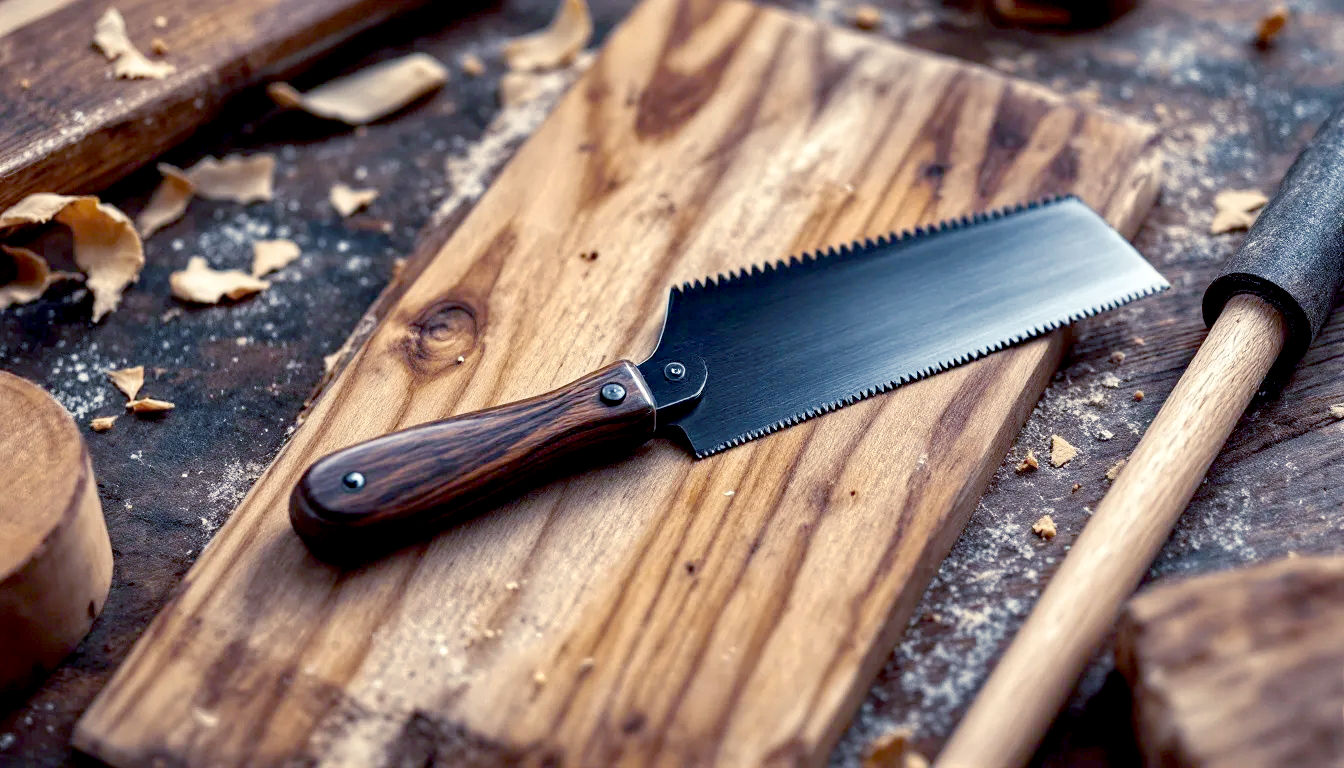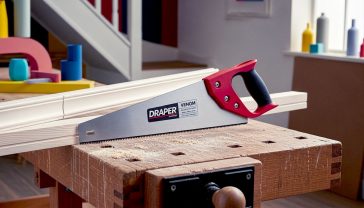The SUIZAN Japanese Flush Cut Saw: Why Your Toolkit Isn’t Complete Without It
An in-depth review of the SUIZAN Japanese Flush Cut Saw, exploring the benefits of pull saws for precise, clean cuts in any British workshop.

This post may contain affiliate links. If you make a purchase through these links, we may earn a commission at no additional cost to you.
If you’ve ever found yourself swearing at a wobbly dowel that just won’t sit flush, or you’ve accidentally scratched a beautiful piece of oak trying to trim a joint, then you’ve stumbled upon the right corner of the internet. For years, many of us in Britain have been brought up on the classic Western “push” saw. It’s what our granddads used in their sheds, a tool as British as a cup of tea and a digestive biscuit. But what if I told you there’s a different way? A method that requires less brute force and offers more precision, turning tricky jobs into moments of quiet satisfaction.
Enter the world of Japanese saws, or nokogiri. Specifically, we’re going to take a deep dive into a little gem that’s been making waves in workshops from Bristol to Aberdeen: the SUIZAN Japanese Flush Cut Saw.
-
Effortless & Precise Cuts: Japanese “pull stroke” design requires less force and creates a cleaner finish than conventional saws.
-
Razor-Sharp Japanese Steel: The blade is forged from premium Japanese steel, ensuring exceptional sharpness and durability.
-
Authentic Craftsmanship: Proudly made in Japan by master craftsmen, continuing a century-old tool-making tradition.
-
Versatile Flush Cutting: A single, robust blade designed to handle a wide range of both hardwoods and softwoods.
-
Lightweight & Compact: Easy to handle and control for intricate and detailed woodworking tasks.
This isn’t just another tool review. This is an exploration of a philosophy of woodworking, a story of centuries-old craftsmanship meeting modern needs. We’ll look at what makes this saw special, why cutting on the pull stroke is a game-changer, and whether this slender piece of Japanese steel truly deserves a place in your toolbox. So, grab a brew, get comfortable, and let’s talk about how this remarkable little saw might just change the way you work with wood forever.
What on Earth is a Japanese Pull Saw?
Before we get into the nitty-gritty of the SUIZAN, let’s get our heads around the fundamental difference between the saws most of us grew up with and their Japanese counterparts. It’s all in the action.
The Push vs. The Pull: A Tale of Two Saws
Imagine sawing a piece of timber. If you’re using a standard Western saw, the teeth are angled away from you. The real work happens on the push stroke, as you drive the blade forward. This requires a fairly rigid, thick blade to stop it from buckling under pressure. Think of it as a bit of a brute-force approach. It gets the job done, no doubt, but it’s not always the most delicate operation.
Now, flip that idea on its head. A Japanese saw, like the SUIZAN, cuts on the pull stroke. The teeth are angled towards the handle. You draw the saw towards you to make the cut. What’s the big deal? Well, this changes everything.
When you pull a blade, it’s naturally held in tension. This means the blade doesn’t need to be thick and heavy to stay straight. It can be incredibly thin, flexible, and delicate. This simple mechanical difference has a cascade of brilliant consequences:
- Less Effort, More Control: Because you’re pulling, you’re not fighting the tool. The saw does the work. It feels less like a workout and more like a precise, controlled movement. One reviewer aptly described it as cutting “like a warm knife through butter.”
- A Cleaner, Thinner Cut: The thin blade removes far less wood. This is called the ‘kerf’. A thinner kerf means less sawdust, a neater finish, and less wasted material. The resulting cut is often so smooth it barely needs sanding.
- Incredible Accuracy: The combination of a thin blade and the pull action gives you pinpoint accuracy. You can start a cut exactly where you want it and follow a line with a level of precision that’s hard to achieve with a clunkier push saw.
For anyone who’s ever tried to make fine, delicate cuts for joinery or finishing, this is a revelation. It’s the difference between shouting at a piece of wood and having a quiet, productive conversation with it.
Meet the SUIZAN 120mm Flush Cut Saw: A Closer Look
SUIZAN is a brand that prides itself on authentic Japanese craftsmanship. Their tools are not mass-produced in a faceless factory; they are made in Tsubame, a city in the Niigata Prefecture of Japan renowned for its metalworking history stretching back centuries. When you hold a SUIZAN saw, you’re holding a piece of that heritage.
The 120mm Flush Cut Saw is a specialist tool, but its uses are surprisingly varied. Let’s break down what makes it tick.
The Blade: A Masterpiece of Engineering
The heart of any saw is its blade, and the SUIZAN’s is exceptional. It’s forged from high-quality Japanese steel, known for its ability to hold a razor-sharp edge. But the real magic is in the details.
Feather-Light and Flexible
The first thing you’ll notice is how incredibly thin and flexible the blade is. At just 0.3mm thick, it feels almost flimsy at first glance. But this flexibility is its superpower. It allows the blade to bend and lie perfectly flat against a surface.
This is the key to “flush cutting.” Imagine you’ve joined two pieces of wood with a wooden dowel. The end of the dowel is sticking out proudly. With a traditional saw, cutting it off without gouging the surrounding wood is a nightmare. With the SUIZAN, you simply lay the flexible blade flat on your main workpiece and gently pull. The blade slices off the protruding dowel perfectly flush, leaving a silky-smooth finish with zero damage to the surrounding area. It’s almost like magic.
Zero Set Teeth: The Secret to a Scratch-Free Finish
Look closely at the teeth of a standard saw. You’ll see they are ‘set’ – slightly bent outwards in an alternating pattern. This makes the cut (the kerf) wider than the blade itself, preventing it from getting stuck.
The SUIZAN flush cut saw, however, has zero set teeth. The teeth are perfectly in line with the blade. This is crucial for flush cutting. Because there’s no set, the teeth won’t scratch the surface you’re resting the blade on. It’s a small detail with a massive impact on the quality of your finish.
A Double-Edged Sword (In a Good Way)
Cleverly, SUIZAN has designed this saw with two cutting edges, each tailored for a different type of wood.
- The Hardwood Edge: This side has 17 teeth per inch (TPI). These are finer teeth, designed for cutting dense woods like oak, maple, or walnut. They take smaller bites, resulting in a very smooth cut and preventing tear-out in these tougher materials.
- The Softwood Edge: The other side features 25 TPI. These are even finer teeth, perfect for softer woods like pine or cedar. The higher tooth count ensures an incredibly clean finish on woods that are prone to splintering.
Having both options on one blade is incredibly convenient. You just flip the saw over depending on the job at hand. A simple arrow and text clearly mark which edge is which.
The Handle: Simple, Effective, and Traditional
The handle is crafted from wood in a traditional Japanese style. It’s long, straight, and designed to be held with one or two hands, allowing for a light but firm grip. Some Western woodworkers might find it unusual at first, as it lacks the pistol-grip ergonomics we’re used to.
However, the design encourages a more delicate approach. You’re not meant to grip it like you’re strangling it. A relaxed hold allows you to guide the blade and let the sharp teeth do the cutting. One user with arthritic fingers praised the large handle, finding it easy and comfortable to use.
Putting It to Work: Where the SUIZAN Shines in a British Workshop
So, it sounds good in theory, but where would you actually use this thing? Is it just a niche tool for master craftsmen, or does it have a place in the average British DIYer’s shed?
The answer is a resounding “yes.” Here are just a few scenarios where the SUIZAN flush cut saw proves its worth time and time again.
The Dowel Destroyer
This is the saw’s bread and butter. Trimming dowels, plugs, and wooden nails is what it was born to do. Whether you’re building furniture, replacing spindles on a staircase, or making toys for the kids, this saw will give you a perfect, flush finish every time. One reviewer mentioned it was “perfect for the precision cuts required and for flush cutting dowel into Newell posts.” That’s a real-world testament to its primary function.
The Joint Tidier-Upper
Have you ever cut a tenon joint that was just a smidge too long? Or made a dovetail that wasn’t quite perfect? The SUIZAN is the ultimate tool for fine-tuning. Its precision allows you to shave off the thinnest slivers of wood to get your joints fitting perfectly. You can trim the ends of through-tenons or tidy up the pins and tails on a dovetail joint without fear of ruining your hard work.
The Awkward Spot Specialist
Because the blade is so flexible and has no rigid spine, it can get into places other saws can only dream of. Need to trim a small piece of architrave already fixed to the wall? Or cut a small notch in a tight corner? The SUIZAN can be gently bent to sneak into these awkward spots, saving you a massive headache.
The Modeller and Miniaturist’s Best Friend
For anyone working on a smaller scale, like model boat building, doll’s house construction, or musical instrument making, this saw is a must-have. Its ability to make precise, paper-thin cuts in delicate materials is unparalleled. It turns what could be a frustrating task with a clumsy craft knife or a bulky junior hacksaw into a simple, controlled process.
The Learning Curve: Getting Used to the Pull Stroke
For those of us who have spent years using push saws, switching to a pull saw does take a little bit of getting used to. It’s not difficult, but it requires a mental shift. As one Canadian user wisely noted, it “took 10 secs to retrain my muscle memory.”
Here are the golden rules for using the SUIZAN effectively:
- Let the Saw Do the Work. This is the most important rule. The blade is incredibly sharp. You do not need to apply downward pressure. Rest the blade on the wood and let its own weight be the only pressure.
- The Pull is for Power, The Push is for Placement. Make your cut on the pull stroke. The push stroke is simply to return the blade to the starting position. Apply almost zero force when pushing it forward. If you push too hard, the thin blade will bend or buckle. A reviewer mentioned the blade “jiggled like Santa’s belly” when they applied too much pressure—a great visual reminder to ease up!
- Start with Your Thumb. To start a cut accurately, place your thumb knuckle next to your cutting line and rest the blade against it to guide the first couple of pull strokes. Once a small groove (kerf) is established, you can remove your thumb and continue.
- Use the Whole Blade. Use long, smooth strokes that utilise the full length of the blade. This is more efficient and helps the blade wear evenly.
- Patience is a Virtue. This is a tool for precision, not speed. Slow down, focus on your technique, and enjoy the process. The clean, accurate results are well worth the extra few seconds.
The Good, The Bad, and The Bendy: An Honest Assessment
No tool is perfect, and it’s important to have a balanced view. Based on hundreds of user reviews and expert opinion, here’s a fair summary of the SUIZAN’s strengths and weaknesses.
The Strengths (Why You’ll Love It)
- Exceptional Sharpness and Cut Quality: The overwhelming consensus is that this saw is razor-sharp right out of the packaging. It leaves a finish that’s often described as “smooth as glass,” requiring little to no sanding.
- Unbeatable Precision: For flush cutting and fine joinery, its accuracy is second to none. It allows for a level of detail and neatness that’s difficult to achieve with other hand saws.
- Fantastic Value for Money: While Japanese saws can be expensive, the SUIZAN is very reasonably priced. Many users comment that for the quality and performance it offers, it represents outstanding value. As one happy customer put it, “it comes at a good price, a price I think is well worth it.”
- Versatility: Despite being a “flush cut” saw, its uses are many. From general DIY to fine woodworking, it’s a tool that you’ll find yourself reaching for more often than you’d expect.
- Authentic Japanese Craftsmanship: There’s a genuine satisfaction in using a tool that is made with such care and tradition. It’s not just a piece of metal and wood; it’s a piece of Japanese heritage.
The Weaknesses (What to Be Aware Of)
- The Blade is Delicate: This is the most common point of concern. The thin, flexible blade is the saw’s greatest strength but also its biggest vulnerability. If you use it incorrectly—by pushing too hard, twisting it, or trying to rush a cut—you can bend or even snap it. One reviewer noted, “My only gripe would be the flimsyness of the blade… I have almost snapped it once or twice.” This isn’t a fault of the saw, but rather a characteristic that demands respect and correct technique. This is not a saw for demolition work or hacking through 4×4 fence posts.
- The Blade is Not Replaceable: On this particular 120mm model, the blade cannot be replaced. Given its low price, this isn’t a deal-breaker for most. If you look after it, the high-quality steel will hold its edge for a very long time. But if you do manage to damage it badly, you’ll be buying a whole new saw.
- Not for Beginners (Who Don’t Listen): An experienced woodworker will pick up this saw and instinctively understand how to use it. A complete novice, however, might try to use it like a Western push saw and quickly become frustrated (and possibly end up with a bent blade). As one user commented, “this saw isn’t for beginners – it cuts very accurately but you do need to be careful.” The key is patience and a willingness to learn the correct, gentle technique.
SUIZAN Flush Cut Saw vs. Western Equivalents
How does the SUIZAN stack up against Western-style flush cut saws?
Western versions, often called trim saws or flexible dovetail saws, also exist. They typically have a thin blade with teeth that have a very slight set or no set at all. However, they are still fundamentally push saws.
The key difference remains the action. The pulling motion of the SUIZAN allows for that gossamer-thin blade, which generally gives a finer kerf and a cleaner cut than its Western counterparts. Furthermore, the double-sided blade for hard and softwoods is a feature not commonly found on Western trim saws.
Ultimately, both can do the job. But for the absolute cleanest, most precise flush cuts with the minimum of effort, the Japanese pull saw philosophy just seems to have the edge.
The Final Verdict: Should You Buy the SUIZAN Japanese Flush Cut Saw?
After sifting through the technical specs, the user experiences, and the philosophy behind its design, the conclusion is remarkably clear.
If you are a serious woodworker, a furniture maker, or a dedicated hobbyist, you should absolutely have this saw in your arsenal. It will perform tasks that other saws simply can’t, and it will do them with a grace and precision that is deeply satisfying. It’s not an everyday saw, but when you need it, you’ll be incredibly glad you have it.
If you are a general DIY enthusiast who enjoys making things out of wood, this saw is one of the best “upgrade” tools you can buy. It will elevate the quality of your finishing and allow you to tackle projects with a new level of neatness. It’s an affordable way to add a touch of professional-level precision to your work. As one reviewer, who built floor-to-ceiling shelves with it, said: “If you are into a bit of DIY woodworking then this is a must have for your tool box.”
This little SUIZAN saw is more than just a tool. It’s an introduction to a different way of thinking about woodworking—one that values precision over power, and finesse over force. It teaches you to slow down, to respect the material, and to find joy in a perfectly executed cut. For less than the price of a decent pub lunch, it offers a gateway into the beautiful and precise world of Japanese craftsmanship. And for that reason alone, it deserves a place of honour in every British workshop.
Further Reading
To continue your journey into the world of Japanese woodworking, check out these highly respected resources:
- Paul Sellers’ Blog: A master woodworker with a wealth of knowledge, often discussing the practical differences between tool types.
- Fine Woodworking Magazine: An excellent resource for in-depth tool reviews and advanced techniques.
- The Woodwright’s Shop: While American, Roy Underhill’s celebration of traditional woodworking is universal and inspiring.







